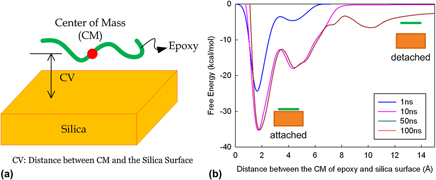Crossref Citations
This article has been cited by the following publications. This list is generated based on data provided by
Crossref.
Lau, Denvid
Büyüköztürk, Oral
and
Buehler, Markus J.
2012.
Multiscale modeling of organic-inorganic interface: From molecular dynamics simulation to finite element modeling.
MRS Proceedings,
Vol. 1466,
Issue. ,
Qin, Zhao
and
Buehler, Markus
2012.
Molecular mechanics of dihydroxyphenylalanine at a silica interface.
Applied Physics Letters,
Vol. 101,
Issue. 8,
p.
083702.
Lau, Denvid
2013.
Moisture effects on nano-mechanical properties of epoxy-based materials.
p.
925.
Gunes, Oguz
Lau, Denvid
Tuakta, Chakrapan
and
Büyüköztürk, Oral
2013.
Ductility of FRP–concrete systems: Investigations at different length scales.
Construction and Building Materials,
Vol. 49,
Issue. ,
p.
915.
Ghosh, Susanta
Kumar, Abhishek
Sundararaghavan, Veera
and
Waas, Anthony M.
2013.
Non-local modeling of epoxy using an atomistically-informed kernel.
International Journal of Solids and Structures,
Vol. 50,
Issue. 19,
p.
2837.
Naderi, Mahmood
and
Hajinasri, S. A.
2013.
Using Twist-off Method for Measuring CFRP/Concrete Adhesion when Exposed to Cyclic Temperature Changes, Wet-Dry and Freeze-Thaw.
The Journal of Adhesion,
Vol. 89,
Issue. 7,
p.
559.
Tam, Lik-ho
and
Lau, Denvid
2014.
Molecular Mechanics of Organic Composite Materials: A Case Study of Cellulose-Adhesive System.
MRS Proceedings,
Vol. 1662,
Issue. ,
Sahoo, Hrushikesh
Rath, Swagat S.
and
Das, Bisweswar
2014.
Use of the ionic liquid-tricaprylmethyl ammonium salicylate (TOMAS) as a flotation collector of quartz.
Separation and Purification Technology,
Vol. 136,
Issue. ,
p.
66.
Yang, Shaorui
and
Qu, Jianmin
2014.
An investigation of the tensile deformation and failure of an epoxy/Cu interface using coarse-grained molecular dynamics simulations.
Modelling and Simulation in Materials Science and Engineering,
Vol. 22,
Issue. 6,
p.
065011.
Lau, Denvid
Broderick, Kurt
Buehler, Markus J.
and
Büyüköztürk, Oral
2014.
A robust nanoscale experimental quantification of fracture energy in a bilayer material system.
Proceedings of the National Academy of Sciences,
Vol. 111,
Issue. 33,
p.
11990.
Yang, Shaorui
and
Qu, Jianmin
2014.
An investigation of the tensile deformation and failure of an epoxy/Cu interface using coarse-grained molecular dynamics simulations.
p.
1.
Chen, Y.
Chia, J.Y.H.
Su, Z.C.
Tay, T.E.
and
Tan, V.B.C.
2014.
Molecular modeling of epoxide-amine systems: Topological cure conversion limit and its influence on material properties.
Polymer,
Vol. 55,
Issue. 23,
p.
6124.
Yu, Zechuan
Xu, Zhiping
and
Lau, Denvid
2014.
Effect of Acidity on Chitin–Protein Interface: A Molecular Dynamics Study.
BioNanoScience,
Vol. 4,
Issue. 3,
p.
207.
Yu, Zechuan
and
Lau, Denvid
2015.
Molecular dynamics study on stiffness and ductility in chitin–protein composite.
Journal of Materials Science,
Vol. 50,
Issue. 21,
p.
7149.
Zhou, Ao
Tam, Lik-ho
Yu, Zechuan
and
Lau, Denvid
2015.
Effect of moisture on the mechanical properties of CFRP–wood composite: An experimental and atomistic investigation.
Composites Part B: Engineering,
Vol. 71,
Issue. ,
p.
63.
Tam, Lik-ho
and
Lau, Denvid
2015.
Moisture effect on the mechanical and interfacial properties of epoxy-bonded material system: An atomistic and experimental investigation.
Polymer,
Vol. 57,
Issue. ,
p.
132.
Lau, Denvid
Qiu, Qiwen
Zhou, Ao
and
Chow, Cheuk Lun
2016.
Long term performance and fire safety aspect of FRP composites used in building structures.
Construction and Building Materials,
Vol. 126,
Issue. ,
p.
573.
Lewis, Christopher
Valenciano, Miguel
and
Cornwell, Charles
2016.
Visualizations of molecular dynamics simulations of high-performance polycrystalline structural ceramics.
Parallel Computing,
Vol. 55,
Issue. ,
p.
35.
Tam, Lik-ho
and
Lau, Denvid
2016.
Effect of structural voids on mesoscale mechanics of epoxybased materials.
Multiscale and Multiphysics Mechanics,
Vol. 1,
Issue. 2,
p.
127.
Sabet, Fereshteh A.
Raeisi Najafi, Ahmad
Hamed, Elham
and
Jasiuk, Iwona
2016.
Modelling of bone fracture and strength at different length scales: a review.
Interface Focus,
Vol. 6,
Issue. 1,
p.
20150055.





